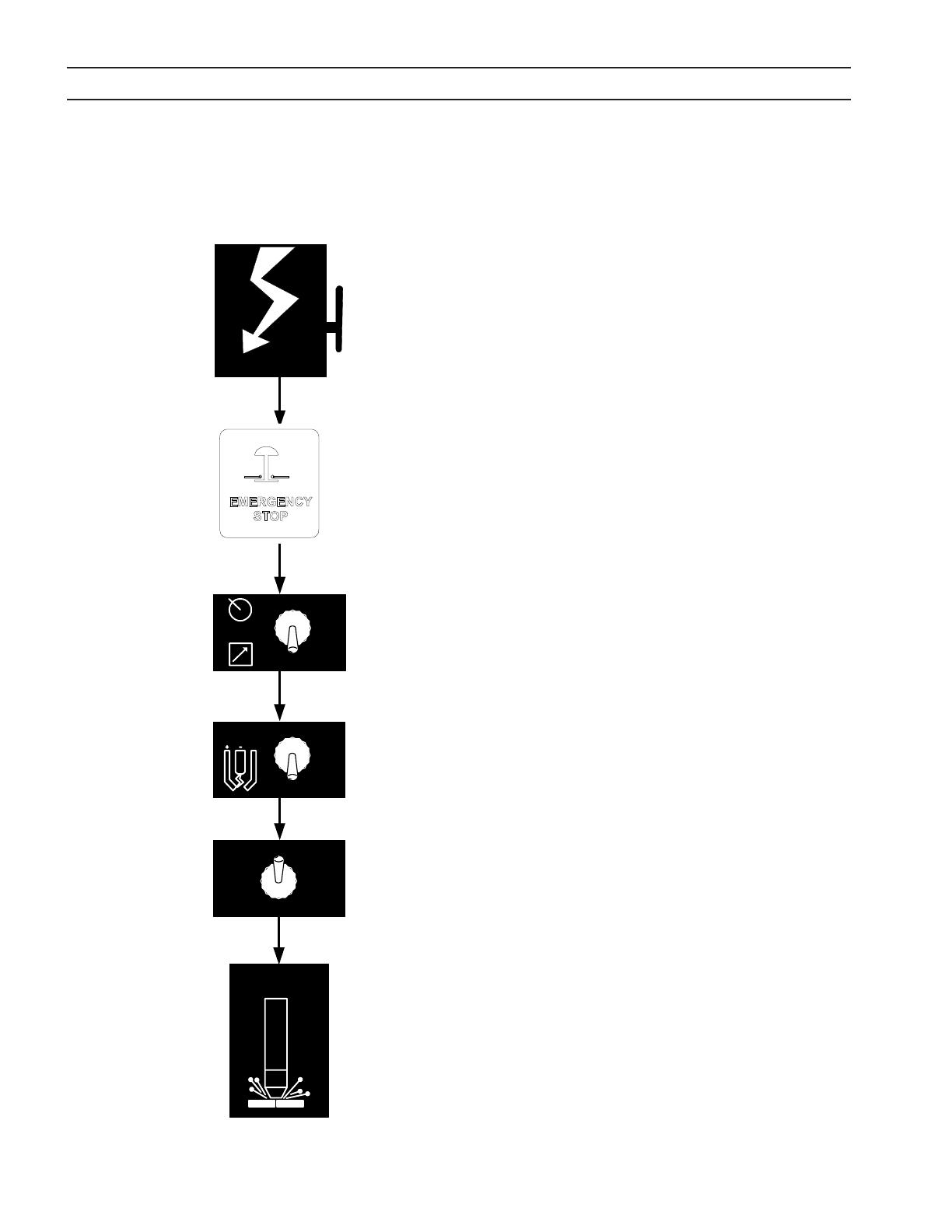
30
SECTION 4 FONCTIONNEMENT
1. Mettez sous tension en fermant l’interrupteur mural de la ligne.
(L’EPP-401/450 n’est pas équipé d’un interrupteur de marche/
arrêt). Le témoin d’alimentation principale va s’éclairer et le
témoin de défaillance va clignoter avant de s’éteindre.
2. Le bouton d’arrêt d’urgence est tiré.
3. Positionner l’interrupteur Panel / Remote (panneau / à dis-
tance).
4. Positonner le commutateur HIGH / LOW (Haute / Basse) de l’arc
pilote. Si ce dernier est sélectionné par commande à distance,
il doit se trouver en position basse. (Consultez les données
de découpe présentées dans le manuel de la torche.)
5. En mode de panneau, contrôlez la tension préétablie par l’in-
termédiaire du commutateur ACTUAL / PRESET AMPS. Réglez
l’intensité jusqu’à ce que la valeur désirée approximative soit
visible sur l’ampèremètre. En mode de commande à distance,
le positionnement du commutateur à bascule ACTUAL AMPS
/ PRESET AMPS sur la position PRESET AMPS fournira la sortie
initiale de courant commandée à distance.
6. Commencez la découpe au plasma. Cette opération peut
inclure le paramétrage manuel d’autres options en fonction
de l’ensemble du kit plasma.
7. En mode de panneau, réglez l’intensité du courant désirée
après le démarrage du processus de découpe.
8. En cas de panne de démarrage de la découpe ou du mar-
quage, vériez le témoin de défaillance. Si l’un d’eux s’allume,
consultez la section relative au dépannage.
Remarque :
Le témoin de défaillance clignote lors de la première
mise sous tension du contacteur signiant que le
bus c.c. a été normalement alimenté.
4.3 Séquence du fonctionnement
SECTION 4 Operation
ESP 400C Plasma Power Source
ESP 400C Plasma Power SourceESP 400C Plasma Power Source
ESP 400C Plasma Power Source
4-4
Begin
Cutting
ACTUAL AMPS
PRESET AMPS
HIGH
LOW
PILOT
ARC
PANEL
REMOTE
Apply Power
4.3 Sequence of Operation
1. Apply power by closing the line (wall) switch.
(The ESP-400C does not have an on/off
switch). The main power light will illuminate
and the fault light will flash and then go out.
2. Select the Panel/Remote setting.
3. Set pilot arc High/Low switch. (Refer to cutting
data in the torch manual.)
4. If using panel mode, view preset amps with the
ACTUAL/PRESET AMPS switch. Adjust current
until the approximate desired value is shown on
the ammeter.
5. Begin plasma cutting operation. This may
include manually setting up other options,
depending on the total plasma package.
6. If using panel mode, after cutting has begun,
adjust current to desired amount.
7. Check for fault light. If a fault light illuminates,
refer to troubleshooting section.
Note: The fault light flashes when the contactor is
Note: The fault light flashes when the contactor isNote: The fault light flashes when the contactor is
Note: The fault light flashes when the contactor is
first turned on signifying the DC Bus powered up
first turned on signifying the DC Bus powered upfirst turned on signifying the DC Bus powered up
first turned on signifying the DC Bus powered up
normally.
normally.normally.
normally.
4.4 Arc Initiation Settings
The time to achieve full current can be adjusted to
suit your particular system. This feature uses 50%
of the cutting current to start, dwell and then
gradually (less than a second) achieve full current.
The ESP-400C is factory shipped with this feature
enabled. The default settings are:
Minimum Start Current 40A
Start Current 50% of cut current
Timing to achieve full current 800 msec
Dwell Time 50 msec
SECTION 4 Operation
ESP 400C Plasma Power Source
ESP 400C Plasma Power SourceESP 400C Plasma Power Source
ESP 400C Plasma Power Source
4-4
Begin
Cutting
ACTUAL AMPS
PRESET AMPS
HIGH
LOW
PILOT
ARC
PANEL
REMOTE
Apply Power
4.3 Sequence of Operation
1. Apply power by closing the line (wall) switch.
(The ESP-400C does not have an on/off
switch). The main power light will illuminate
and the fault light will flash and then go out.
2. Select the Panel/Remote setting.
3. Set pilot arc High/Low switch. (Refer to cutting
data in the torch manual.)
4. If using panel mode, view preset amps with the
ACTUAL/PRESET AMPS switch. Adjust current
until the approximate desired value is shown on
the ammeter.
5. Begin plasma cutting operation. This may
include manually setting up other options,
depending on the total plasma package.
6. If using panel mode, after cutting has begun,
adjust current to desired amount.
7. Check for fault light. If a fault light illuminates,
refer to troubleshooting section.
Note: The fault light flashes when the contactor is
Note: The fault light flashes when the contactor isNote: The fault light flashes when the contactor is
Note: The fault light flashes when the contactor is
first turned on signifying the DC Bus powered up
first turned on signifying the DC Bus powered upfirst turned on signifying the DC Bus powered up
first turned on signifying the DC Bus powered up
normally.
normally.normally.
normally.
4.4 Arc Initiation Settings
The time to achieve full current can be adjusted to
suit your particular system. This feature uses 50%
of the cutting current to start, dwell and then
gradually (less than a second) achieve full current.
The ESP-400C is factory shipped with this feature
enabled. The default settings are:
Minimum Start Current 40A
Start Current 50% of cut current
Timing to achieve full current 800 msec
Dwell Time 50 msec




















